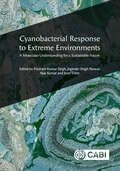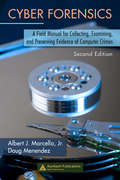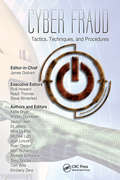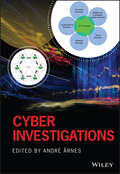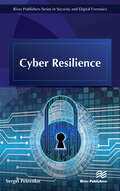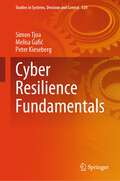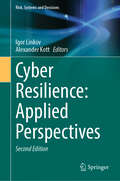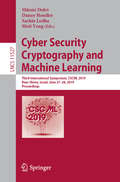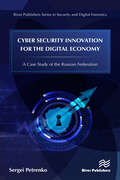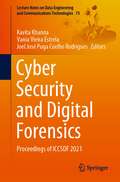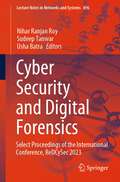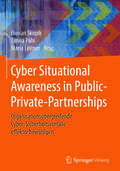- Table View
- List View
Cyanobacterial Response to Extreme Environments: A Molecular Understanding for a Sustainable Future
by Ajay Kumar Josef Elster Prashant Kumar Singh Joginder Singh PanwarCyanobacteria are the oldest living organisms on Earth, going back to the Precambrian era and the planet's early harsh climate. Cyanobacteria inhabit almost all environmental niches. These prokaryotes were critical to the formation of the current biosphere as they evolved photosynthetic reactions emitting oxygen similar to those of plants and green algae. They continue to contribute to the equilibrium of the Earth's atmosphere by generating oxygen and eliminating carbon dioxide. In addition, heterocystous cyanobacteria (specialized nitrogen-fixing cells formed during nitrogen starvation) contribute to atmospheric nitrogen fixation. Therefore, cyanobacteria have tremendous potential for biotechnological applications. Cyanobacteria have evolved specific regulatory mechanisms to cope with environmental stresses and/or variable environments, such as high altitude, extreme cold, hot water and springs, and volcanic ash. However, cyanobacterial adaptation mechanisms to environmental extremes have been poorly addressed, despite their ubiquitous presence in such ecological extremes. Over the last decade, remarkable progress has been made to uncover cyanobacterial adaptation to various abiotic stresses such as high irradiance, nutritional deprivation, UV-B radiation, heat, cold, desiccation, heavy metals, and radiation. These studies must lead the way to a basic understanding of cyanobacterial gene regulatory pathways for morphological, physiological, metabolic, and genetic adaptations to environmental stress. Unfortunately, until now, this information has been scattered in the literature. This book reviews and provides an up-to-date snapshot of where current research stands, as well as discussing the different aspects of cyanobacterial adaptation to extreme environments and their potential for biotechnological exploitation and future research. This book is aimed at researchers and graduate students involved in any aspect of research into cyanobacteria, extreme environments and the exploitation of these organisms in biotechnological applications.
Cyanobacterial Toxins of Drinking Water Supplies
by Ian Robert FalconerThe contamination of both drinking and recreational water supplies by cyanobacteria is increasingly a cause for concern worldwide. While contamination causes livestock deaths with relative frequency, acute poisoning is rare in humans. However, there is growing apprehension over the possible role of cylindrospermopsins and microcystins in gastrointe
Cyanotoxins in Drinking Water: Fundamental Concepts and Solutions
by Harold WalkerThis textbook provides students with a more holistic, systems-based perspective of harmful algal blooms, or HABs and HAB toxins, while explaining details on occurrence, health effects, and treatment processes for the removal of HAB cells and toxins from drinking water. It includes significant content on basic concepts, and system design, and includes thought-provoking problems and questions to inspire further studying, making it suitable for senior undergraduate and graduate-level students. It also serves as a useful resource for professionals and academics in technical activities related to HABs and HAB toxins in drinking water.Features Provides answers to the complex problem of HABs and HAB toxins in drinking water, as well as an up-to-date review of the literature. Covers solutions to HABs and HAB toxins in drinking water in the context of a changing climate. Explains key concepts and terms, detailed analysis, and design examples, in an easy-to-understand language for students and professionals interested in HABs. Includes worked example problems and numerous questions to better illustrate the concepts and solutions to HABs and HAB toxins in drinking water. A “Solutions Manual” is provided. Offers comprehensive coverage of HABs and HAB toxins in drinking water, from occurrence to in situ treatment to treatment in treatment facilities. Features case studies from different countries that have proposed regulations for HABs and related toxins in drinking water. This is an excellent resource for use in courses that take an interdisciplinary approach to water treatment, such as environmental, marine, and atmospheric sciences. It can be used also for continuing education in water-treatment-related fields, and a reference for technical activities related to HABs and HAB toxins in drinking water.
Cyber Attack Information System: Erfahrungen und Erkenntnisse aus der IKT-Sicherheitsforschung (Xpert.press)
by Florian Skopik Helmut Leopold Thomas BleierIn den letzten Jahren hat sich das Internet schnell zu einem massiven wirtschaftlichen Betätigungsfeld entwickelt, leider auch für illegale Unternehmungen. Das Ausnutzen von Schwachstellen in IKT-Systemen ist inzwischen ein profitables Geschäftsmodell. Das staatlich geförderte Forschungsprojekt CAIS beschäftigte sich deshalb mit der Implementierung eines Cyber Attack Information Systems auf nationaler Ebene mit dem Ziel, die Widerstandsfähigkeit der heutigen vernetzten Systeme zu stärken und ihre Verfügbarkeit und Vertrauenswürdigkeit zu erhöhen. Hauptziele dieses Projektes waren die Identifizierung der künftigen Cyber-Risiken und -Bedrohungen, die Untersuchung neuartiger Techniken zur Anomalieerkennung, die Entwicklung modularer Infrastrukturmodelle und agentenbasierter Simulationen zur Risiko- und Bedrohungsanalyse, und schließlich die Analyse und mögliche Umsetzung eines nationalen Cyber Attack Information Systems.
Cyber Criminology: Exploring Internet Crimes and Criminal Behavior
by K. JaishankarVictimization through the Internet is becoming more prevalent as cyber criminals have developed more effective ways to remain anonymous. And as more personal information than ever is stored on networked computers, even the occasional or non-user is at risk. A collection of contributions from worldwide experts and emerging researchers, Cyber Crimino
Cyber Forensics: A Field Manual for Collecting, Examining, and Preserving Evidence of Computer Crimes, Second Edition
by Albert Marcella Jr. Doug MenendezUpdating and expanding information on concealment techniques, new technologies, hardware, software, and relevant new legislation, this second edition details scope of cyber forensics to reveal and track legal and illegal activity. Designed as an introduction and overview to the field, the authors guide you step-by-step through the basics of investigation and introduce the tools and procedures required to legally seize and forensically evaluate a suspect machine. The book covers rules of evidence, chain of custody, standard operating procedures, and the manipulation of technology to conceal illegal activities and how cyber forensics can uncover them.
Cyber Forensics: Examining Emerging and Hybrid Technologies
by Albert J. MarcellaThreat actors, be they cyber criminals, terrorists, hacktivists or disgruntled employees, are employing sophisticated attack techniques and anti-forensics tools to cover their attacks and breach attempts. As emerging and hybrid technologies continue to influence daily business decisions, the proactive use of cyber forensics to better assess the risks that the exploitation of these technologies pose to enterprise-wide operations is rapidly becoming a strategic business objective. This book moves beyond the typical, technical approach to discussing cyber forensics processes and procedures. Instead, the authors examine how cyber forensics can be applied to identifying, collecting, and examining evidential data from emerging and hybrid technologies, while taking steps to proactively manage the influence and impact, as well as the policy and governance aspects of these technologies and their effect on business operations. A world-class team of cyber forensics researchers, investigators, practitioners and law enforcement professionals have come together to provide the reader with insights and recommendations into the proactive application of cyber forensic methodologies and procedures to both protect data and to identify digital evidence related to the misuse of these data. This book is an essential guide for both the technical and non-technical executive, manager, attorney, auditor, and general practitioner who is seeking an authoritative source on how cyber forensics may be applied to both evidential data collection and to proactively managing today’s and tomorrow’s emerging and hybrid technologies. The book will also serve as a primary or supplemental text in both under- and post-graduate academic programs addressing information, operational and emerging technologies, cyber forensics, networks, cloud computing and cybersecurity.
Cyber Fraud: Tactics, Techniques and Procedures
by Rick HowardWith millions lost each year, cyber crime has evolved from a minor nuisance to a major concern involving well-organized actors and highly sophisticated organizations. Arguably one of the most important challenges of the 21st century, with millions lost each year, cyber crime has evolved from a minor nuisance to a major concern involving well-organized actors and highly sophisticated organizations. This volume explores the state of threats present in the cyber fraud underground. It discusses phishing/pharming, trojans/toolkits, direct threats, and pump-and-dump scams. By examining the operations of the cyber criminal, the book provides perspective into the general incentives, risks, and behavioral patterns of the fraudsters. Armed with this information, organizations and individuals are better able to develop countermeasures and crafting tactics to disrupt the fraud underground and secure their systems.
Cyber Infrastructure for the Smart Electric Grid (IEEE Press)
by Anurag K. Srivastava Venkatesh Venkataramanan Carl HauserExplore a thorough treatment of the foundations of smart grid sensing, communication, computation, and control As electric power systems undergo a transformative upgrade with the integration of advanced technologies to enable the smarter electric grid, professionals who work in the area require a new understanding of the evolving complexity of the grid. Cyber Infrastructure for the Smart Electric Grid delivers a comprehensive overview of the fundamental principles of smart grid operation and control, smart grid technologies, including sensors, communication networks, computation, data management, and cyber security, and the interdependencies between the component technologies on which a smart grid’s security depends. The book offers readers the opportunity to critically analyze the smart grid infrastructure needed to sense, communicate, compute, and control in a secure way. Readers of the book will be able to apply the interdisciplinary principles they’ve learned in the book to design and build secure smart grid infrastructure. Readers will also benefit from the inclusion of: A thorough introduction to the key skills required by engineers to manage the evolving complexity of the electric grid An exploration of the interdependencies of smart grid infrastructure required to sense, communicate, compute, control, and manage data securely Software modules in .exe format for demonstrations and exercises An examination of the fundamental principles of smart grid operation and control Perfect for professionals working in the electric utility industries at electric utilities, vendors, and the national labs, Cyber Infrastructure for the Smart Electric Grid will also earn a place in the libraries of senior undergraduate and graduate students studying electrical engineering and smart grids.
Cyber Investigations
by André ÅrnesCYBER INVESTIGATIONS A classroom tested introduction to cyber investigations with real-life examples included Cyber Investigations provides an introduction to the topic, an overview of the investigation process applied to cyber investigations, a review of legal aspects of cyber investigations, a review of Internet forensics and open-source intelligence, a research-based chapter on anonymization, and a deep-dive in to multimedia forensics. The content is structured in a consistent manner, with an emphasis on accessibility for students of computer science, information security, law enforcement, and military disciplines. To aid in reader comprehension and seamless assimilation of the material, real-life examples and student exercises are provided throughout, as well as an Educational Guide for both teachers and students. The material has been classroom-tested and is a perfect fit for most learning environments. Written by a highly experienced author team with backgrounds in law enforcement, academic research, and industry, sample topics covered in Cyber Investigations include: The cyber investigation process, including developing an integrated framework for cyber investigations and principles for the integrated cyber investigation process (ICIP) Cyber investigation law, including reasonable grounds to open a criminal cyber investigation and general conditions for privacy-invasive cyber investigation methods Perspectives of internet and cryptocurrency investigations, including examples like the proxy seller, the scammer, and the disgruntled employee Internet of things (IoT) investigations, including types of events leading to IoT investigations and new forensic challenges in the field Multimedia forensics facilitates the understanding of the role of multimedia in investigations, including how to leverage similarity matching, content-based tracing, and media metadata. Anonymization networks discusses how such networks work, and how they impact investigations? It addresses aspects of tracing, monitoring, evidence acquisition, de-anonymization, and large investigations Based on research, teaching material, experiences, and student feedback over several years, Cyber Investigations is ideal for all students and professionals in the cybersecurity industry, providing comprehensive subject coverage from faculty, associates, and former students of cyber security and digital forensics at the Norwegian University of Science and Technology (NTNU).
Cyber Law and Ethics: Regulation of the Connected World
by Eric P. Robinson Mark GrabowskiA primer on legal issues relating to cyberspace, this textbook introduces business, policy and ethical considerations raised by our use of information technology. With a focus on the most significant issues impacting internet users and businesses in the United States of America, the book provides coverage of key topics such as social media, online privacy, artificial intelligence and cybercrime as well as emerging themes such as doxing, ransomware, revenge porn, data-mining, e-sports and fake news. The authors, experienced in journalism, technology and legal practice, provide readers with expert insights into the nuts and bolts of cyber law. Cyber Law and Ethics: Regulation of the Connected World provides a practical presentation of legal principles, and is essential reading for non-specialist students dealing with the intersection of the internet and the law.
Cyber Physical Energy Systems
by T. Poongodi Sanjeevikumar Padmanaban Shrddha Sagar Rajesh Kumar DhanarajThis book is essential for understanding the transformative integration of cyber-physical systems in smart grids, providing valuable insights that will shape the future of sustainable energy production and distribution. A novel modeling methodology that blends cyber and physical components is a significant advancement for future energy systems. A Cyber-Physical System (CPS) is an integrated component of physical microgrids that combines computers, wireless connections, and controls to create a holistic solution. As a result of cyber-physical systems, a new generation of engineering systems incorporating wireless communication has begun to emerge. Despite that there are various major CPS systems in use today, one of the most challenging sectors for implementation is the smart grid which aims to distribute dependable and efficient electric energy while maintaining a high level of global environmental sustainability. Smart grids incorporate advanced monitoring to ensure a secure, efficient energy supply, enhancing generator and distributor performance while offering consumers more choices. These systems aim to boost the capacity and responsiveness of energy production, transmission, distribution, and consumption. As renewable energy sources grow, traditional methods are being challenged, requiring cross-domain integration of energy systems and data. This book explores architectures and methods for integrating cutting-edge technology into the power grid for more sustainable energy production and distribution.
Cyber Resilience (River Publishers Series In Security And Digital Forensics Ser.)
by Sergei PetrenkoModern cyber systems acquire more emergent system properties, as far as their complexity increases: cyber resilience, controllability, self-organization, proactive cyber security and adaptability. Each of the listed properties is the subject of the cybernetics research and each subsequent feature makes sense only if there is a previous one.Cyber resilience is the most important feature of any cyber system, especially during the transition to the sixth technological stage and related Industry 4.0 technologies: Artificial Intelligence (AI), Cloud and foggy computing, 5G +, IoT/IIoT, Big Data and ETL, Q-computing, Blockchain, VR/AR, etc. We should even consider the cyber resilience as a primary one, because the mentioned systems cannot exist without it. Indeed, without the sustainable formation made of the interconnected components of the critical information infrastructure, it does not make sense to discuss the existence of 4.0 Industry cyber-systems. In case when the cyber security of these systems is mainly focused on the assessment of the incidents' probability and prevention of possible security threats, the cyber resilience is mainly aimed at preserving the targeted behavior and cyber systems' performance under the conditions of known (about 45 %) as well as unknown (the remaining 55 %) cyber attacks.This monograph shows that modern Industry 4.0. Cyber systems do not have the required cyber resilience for targeted performance under heterogeneous mass intruder cyber-attacks. The main reasons include a high cyber system structural and functional complexity, a potential danger of existing vulnerabilities and “sleep” hardware and software tabs, as well as an inadequate efficiency of modern models, methods, and tools to ensure cyber security, reliability, response and recovery.
Cyber Resilience Fundamentals (Studies in Systems, Decision and Control #520)
by Peter Kieseberg Simon Tjoa Melisa GafićThis book provides readers with the necessary capabilities to meet the challenge of building and testing resilient IT services. Upon introducing the fundamentals of cyber resilience with important international standards and best practices, and the risk management process, the book covers in detail the cyber resilience management process. Here, it gives insights into the principles and design criteria to build cyber resilience in organizations, and to integrate it into operations to contribute to incident preparedness. Further, it describes measures for incident handling, including detection, containment, and post-incident handling, and analyses the most critical aspects of cyber resilience testing, such as auditing, exercising, and testing. Written for advanced undergraduate students attending information security and business continuity management courses, this book also addresses researchers and professionals in the broad field of IT Security and cyber resilience.
Cyber Resilience: Applied Perspectives (Risk, Systems and Decisions)
by Alexander Kott Igor LinkovResilience is defined as the ability to recover from or easily adapt to shocks and stresses. Resilience, unlike the concept of security (which is often and incorrectly conflated with resilience) refers to the system's ability to recover or regenerate its performance after an unexpected impact produces a degradation in its performance. A clear understanding of distinction between security, risk and resilience is important for developing appropriate management of cyber threats. This books draws expertise from academia, industry, and government to present insightful discussion of the fundamental concepts of cyber resilience, including the most current technical issues, relevant methods and procedures, and recent developments of the field. This book offers greater emphasis on applying the concepts and methods of cyber resilience to practical problems as compared to our previous book. The bulk of the material is presented in a logical, consistent, and continuous way that is easily accessible to non-specialists and will be of use as teaching material as well as source of emerging scholarship in the field.
Cyber Security Cryptography and Machine Learning: Third International Symposium, CSCML 2019, Beer-Sheva, Israel, June 27–28, 2019, Proceedings (Lecture Notes in Computer Science #11527)
by Moti Yung Shlomi Dolev Sachin Lodha Danny HendlerThis book constitutes the refereed proceedings of the Third International Symposium on Cyber Security Cryptography and Machine Learning, CSCML 2019, held in Beer-Sheva, Israel, in June 2019.The 18 full and 10 short papers presented in this volume were carefully reviewed and selected from 36 submissions. They deal with the theory, design, analysis, implementation, or application of cyber security, cryptography and machine learning systems and networks, and conceptually innovative topics in these research areas.
Cyber Security Innovation for the Digital Economy: A Case Study of the Russian Federation (River Publishers Series In Security And Digital Forensics Ser.)
by Sergei PetrenkoCyber Security Innovation for the Digital Economy considers possible solutions to the relatively new scientific-technical problem of developing innovative solutions in the field of cyber security for the Digital Economy. The solutions proposed are based on the results of exploratory studies conducted by the author in the areas of Big Data acquisition, cognitive information technologies (cogno-technologies), new methods of analytical verification of digital ecosystems on the basis of similarity invariants and dimensions, and “computational cognitivism,” involving a number of existing models and methods.In practice, this successfully allowed the creation of new entities - the required safe and trusted digital ecosystems - on the basis of the development of digital and cyber security technologies, and the resulting changes in their behavioral preferences. Here, the ecosystem is understood as a certain system of organizations, created around a certain Technological Platform that use its services to make the best offers to customers and access to them to meet the ultimate needs of clients - legal entities and individuals. The basis of such ecosystems is a certain technological platform, created on advanced innovative developments, including the open interfaces and code, machine learning, cloud technologies, Big Data collection and processing, artificial intelligence technologies, etc. The mentioned Technological Platform allows creating the best offer for the client both from own goods and services and from the offers of external service providers in real time.This book contains four chapters devoted to the following subjects:- Relevance of the given scientific-technical problems in the cybersecurity of Digital Economy- Determination of the limiting capabilities- Possible scientific and technical solutions- Organization of perspective research studies in the area of Digital Economy cyber security in Russia.
Cyber Security and Digital Forensics: Proceedings of ICCSDF 2021 (Lecture Notes on Data Engineering and Communications Technologies #73)
by Vania Vieira Estrela Kavita Khanna Joel José Puga Coelho RodriguesThis book features high-quality research papers presented at the International Conference on Applications and Techniques in Cyber Security and Digital Forensics (ICCSDF 2021), held at The NorthCap University, Gurugram, Haryana, India, during April 3–4, 2021. This book discusses the topics ranging from information security to cryptography, mobile application attacks to digital forensics, and from cyber security to blockchain. The goal of the book is to provide 360-degree view of cybersecurity to the readers which include cyber security issues, threats, vulnerabilities, novel idea, latest technique and technology, and mitigation of threats and attacks along with demonstration of practical applications. This book also highlights the latest development, challenges, methodologies as well as other emerging areas in this field. It brings current understanding of common Web vulnerabilities while maintaining awareness and knowledge of contemporary standards, practices, procedures, and methods of Open Web Application Security Project. It also expounds how to recover information after a cybercrime.
Cyber Security and Digital Forensics: Select Proceedings of the 2nd International Conference, ReDCySec 2024 (Lecture Notes in Networks and Systems #1287)
by Pradeep Kumar Nihar Ranjan Roy Amit Prakash Singh Ajay KaulThis book features peer-reviewed papers from the International Conference on Recent Developments in Cyber Security, organized by the Center for Cyber Security and Cryptology. It focuses on key topics such as information privacy and secrecy, cryptography, cyber threat intelligence and mitigation, cyber-physical systems, quantum cryptography, and blockchain technologies and their applications. This volume is a unique collection of chapters from various disciplines united by a common theme, making it immensely valuable for both academic researchers and industry practitioners.
Cyber Security and Digital Forensics: Select Proceedings of the International Conference, ReDCySec 2023 (Lecture Notes in Networks and Systems #896)
by Usha Batra Nihar Ranjan Roy Sudeep TanwarThe book contains peer-reviewed papers from the International Conference on Recent Developments in Cyber Security organized by the Center for Cyber Security and Cryptology at Sharda University in June 2023. This volume focuses on privacy and secrecy of information, cryptography, applications and analysis, cyber threat intelligence and mitigation, cyber-physical systems, cyber threat intelligence, quantum cryptography and blockchain technologies and their application, etc. This book is a unique collection of chapters from different areas with a common theme and will be immensely useful to academic researchers and practitioners in the industry.
Cyber Security in India: Education, Research and Training (IITK Directions #4)
by Sandeep Kumar Shukla Manindra AgrawalThis book of 'directions' focuses on cyber security research, education and training in India, and work in this domain within the Indian Institute of Technology Kanpur. IIT Kanpur's Computer Science and Engineering Department established an ‘Interdisciplinary Center for Cyber Security and Cyber Defense of Critical Infrastructures (C3I Center)’ in 2016 with funding from the Science and Engineering Research Board (SERB), and other funding agencies. The work at the center focuses on smart grid security, manufacturing and other industrial control system security; network, web and data security; cryptography, and penetration techniques. The founders are involved with various Indian government agencies including the Reserve Bank of India, National Critical Information Infrastructure Protection Center, UIDAI, CCTNS under home ministry, Ministry of IT and Electronics, and Department of Science & Technology. The center also testifies to the parliamentary standing committee on cyber security, and has been working with the National Cyber Security Coordinator's office in India. Providing glimpses of the work done at IIT Kanpur, and including perspectives from other Indian institutes where work on cyber security is starting to take shape, the book is a valuable resource for researchers and professionals, as well as educationists and policymakers.
Cyber Security: 19th China Annual Conference, CNCERT 2022, Beijing, China, August 16–17, 2022, Revised Selected Papers (Communications in Computer and Information Science #1699)
by Wei Lu Chao Li Weiping Wen Hanbing Yan Yuqing ZhangThis open access book constitutes the refereed proceedings of the 18th China Annual Conference on Cyber Security, CNCERT 2022, held in Beijing, China, in August 2022. The 17 papers presented were carefully reviewed and selected from 64 submissions. The papers are organized according to the following topical sections: data security; anomaly detection; cryptocurrency; information security; vulnerabilities; mobile internet; threat intelligence; text recognition.
Cyber Security: Ein Einblick für Wirtschaftswissenschaftler (essentials)
by Sebastian KlipperIn diesem Buch erfahren Wirtschaftswissenschaftler, wie Firmen nach Hackerangriffen vom Markt verschwinden und wie Hacker Aktienkurse beeinflussen können. Lernen Sie, wie Homo oeconomicus beim Thema Cyber Security zum Homo carens securitate wird und wie es gelingt, mithilfe der wirtschaftswissenschaftlichen ,,Brille" (oder: Perspektive/Sicht) ganz neue Lösungsansätze und Sichtweisen im Kampf gegen Wirtschaftsspione, Hacker und Cyber-Kriminelle zu erkennen. Cyber Security bzw. IT-Sicherheit ist ein Zukunftsthema, an dem kaum jemand vorbeikommt. Dieses Buch beschreibt anhand aktueller Vorfälle - ohne technisches Grundwissen vorauszusetzen -, was Ökonomen wissen müssen, um sich am Gespräch über eines der wichtigsten Zukunftsthemen unserer Zeit beteiligen zu können.
Cyber Situational Awareness in Public-Private-Partnerships: Organisationsübergreifende Cyber-Sicherheitsvorfälle effektiv bewältigen
by Florian Skopik Maria Leitner Tímea PáhiDigitale Dienste werden für unsere Gesellschaft immer wichtiger, daher gelangen sie auch stärker ins Visier von Wirtschaftskriminellen, Spionen, Terroristen oder staatsfeindlichen Gruppierungen. Wie schützen sich Unternehmen und Staaten vor solchen Cyber-Attacken? Ein wichtiger Grundstein ist die Schaffung von Behörden, wie sie die EU-Richtlinie über Maßnahmen zur Gewährleistung eines hohen gemeinsamen Sicherheitsniveaus von Netz- und Informationssystemen (NIS) vorsieht. Das Buch zeigt, wie sich die Zusammenarbeit von Unternehmen mit diesen NIS-Behörden gestaltet mit dem gemeinsamen Ziel, Cyber-Sicherheit zu etablieren und zu gewährleisten. Darüber hinaus legen die Autoren dar, wie sich die NIS-Richtlinie und die im Mai 2018 in Kraft getretene EU-Datenschutz-Grundverordnung (DSGVO) auf Security-Prozesse in Unternehmen auswirken können. Das Buch verknüpft technische, organisatorische und rechtliche Aspekte der Zusammenarbeit und spiegelt damit die Komplexität des Themas wider. Zugleich liefert es zahlreiche Vorschläge zur Umsetzung der EU-Richtlinie. Im Mittelpunkt steht dabei das Konzept der „Cyber Situational Awareness“ – das bewusste Erfassen der aktuellen Lage – und damit ein Instrument, mit dem sich die Reaktionsfähigkeit bei Cyber-Angriffen wesentlich erhöhen lässt. Folgende Themen werden erläutert: • Aufbau und Nutzung von Cyber Situational Awareness • Erstellung von Cyber-Lagebildern auf nationaler Ebene • Informations- und Datenquellen für Cyber-Lagebilder• Informationsaustausch zwischen Cyber-Lagezentren und Stakeholdern • Informations- und Meldepflichten von Unternehmen• Planspiel zur Bildung und Evaluierung von Cyber Situational Awareness
Cyber Victimology: Decoding Cyber-Crime Victimisation
by Debarati HalderCyber Victimology provides a global socio-legal-victimological perspective on victimisation online, written in clear, non-technical terms, and presents practical solutions for the problem. Halder qualitatively analyzes the contemporary dimensions of cyber-crime victimisation, aiming to fill the gap in the existing literature on this topic. A literature review, along with case studies, allows the author to analyze the current situation concerning cyber-crime victimisation. A profile of victims of cyber-crime has been developed based on the characteristics of different groups of victims. As well, new policy guidelines on the basis of UN documents on cybercrimes and victim justice are proposed to prevent such victimisation and to explore avenues for restitution of justice for cases of cyber-crime victimisation. This book shows how the effects of cyber victimisation in one sector can affect others. This book also examines why perpetrators choose to attack their victim/s in specific ways, which then have a ripple effect, creating greater harm to other members of society in unexpected ways. This book is suitable for use as a textbook in cyber victimology courses and will also be of great interest to policy makers and activists working in this area.
